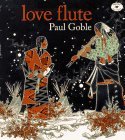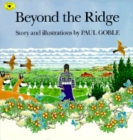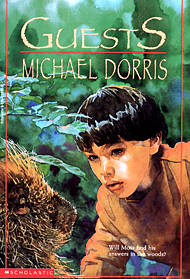

Native American Literature

Goble, Paul. Love flute. New York: Bradbury
Press, 1992. ISBN 0-02-736261-2.
This is the story of a young Native American man who was in love with a beautiful girl from his village. His problem was that he was too shy to let her know. The other men in the village courted her and he wished he could do the same. One morning he left the camp, disappointed and dismayed. He shot an arrow without caring where it went. Surprisingly, the arrow did not land the entire day. The man followed it until it landed by a stream. This went on for four days. As he lay down to sleep, he heard voices whispering near him. He saw two Elk Men above him. They gave him a flute that they described as being made by all the animals and birds. The young man accepted the flute and made his way back to his village. Along the way, he listened to the birds and animals. When he got back to his village, he played his flute. All the women in the camp were attracted to the beautiful sound, but the one girl knew the songs were for her.
In the beginning of this book, Goble presents background knowledge about the origin of the love flute. Although Goble does not directly state (within the story) which Native American culture this story depicts, the illustrations show the characters to be of the Great Plains. There is a very strong nature connection in this story; the animals play a crucial role in helping the young man succeed in his quest to win the love of the beautiful girl.
Goble gives tribute to the many traditional stories from which he got the ideas for this book. He also lists the references for his ideas in his artwork. The illustrations are done in bright colors. The characters facial features are left to a minimum, a sign of respect for the culture. Each two-page spread contains a black and white drawing of a traditional love flute. Each flute is different, and each has the form of an animal: different birds, a snake, a horse.
 Goble,
Paul. Beyond the ridge. New York: Bradbury
Press, 1989. ISBN 0-02-736581-6.
Goble,
Paul. Beyond the ridge. New York: Bradbury
Press, 1989. ISBN 0-02-736581-6.
This is the story of an old Plains woman’s journey to the “Land of Many Tipis.” The woman lay dying in her bed, with her family all around her. She hears a voice that beckons her. Her spirit gets up and begins the journey away from her camp, up the steep ridge. As she reaches the top of the ridge, she sees the most beautiful view she has ever seen. The land below is filled with beautiful birds and butterflies, flowers, and a circle of tipis that belonged to all of the people who had gone before her.
Meanwhile, the woman’s family prepares her body for her journey. They dress her in her favorite dress, paint her face red, wrap her in a buffalo robe and place with her all of her important things. They carry her to a platform in a tree, where the earth would “soon take back her body.”
The story goes on to describe the Plains’ belief that this life leads into the next and how everyone will come to a fork in the trail where they will meet Hinhan Kara, who chooses which direction their soul will take.
Many Plains traditions are woven throughout the text and illustrations in this book. Although not Plains by birth, Goble is an adopted member of the Yakima and Sioux tribes. His knowledge of the traditions of the tribes is very evident in his writing and illustrations. He includes a note at the beginning of the book, in which he explains many of the images the reader will find. In his traditional style, Goble leaves the characters’ faces very plain, without any detail, and he explains the thought behind this technique in his author’s notes. The images are bold and colorful and each contains tiny details that reflect Plains traditions, such as the woman carrying a bundle of sage leaves, and the crows that fly near her body. The beginning and the end of the book present traditional Plains prayers and thoughts about life and death.
This is one of Paul Goble’s most thought-provoking books. Anyone who has ever experienced the death of a loved one should read this book.
 Dorris,
Michael. Guests. New York: Hyperion,
1994. ISBN 0-7868-2036-5.
Dorris,
Michael. Guests. New York: Hyperion,
1994. ISBN 0-7868-2036-5.
Moss is a young Native American boy who is frustrated because he believes he is ready to become a man. He goes to the woods because he is angry that his father invited strangers to their thanks-giving celebration. There he meets Trouble, a girl his age of another clan, who is struggling with issues of her own. The two must deal with the fact that they are interested in each other, but they must obey their tribe’s rules; they are not allowed to look each other in the eye, nor should they even be out in the woods together. In their discussion, they try to out-do each other and Moss runs off deeper into the woods for his “away time.” He soon finds he is lost and must deal with his fears. During his unexpected away time, he meets up with a wise porcupine who makes him think about who he is and the importance of his surroundings. After what Moss believes is many days, he finds Trouble once again. She leads him back to their village and he realizes he has only been in the woods a few hours at best. The strangers are there and Moss and Trouble try to blend into the celebration with their families. Trouble gets hit because she had been gone. She runs and joins Moss’ family. His family accepts her as one of their own.
The story is set somewhere in the eastern part of North America. Although no mention is made of the exact location, the village is described as being separated from the sea by grassy bluffs. Moss’ grandfather’s home is described as wide and round, with bark sides, leading one to believe it may be a wigwam, which was a traditional home of the Algonquin. The many references to nature helps the reader experience the story as if he were actually there. Dorris’ multi-sensory description of the green lichen covering a boulder, feeling as smooth and sleek as mink fur, gives the reader a definitive image.
Dorris’ characters are strong, but subtle. Moss’ father deals with his unhappiness or uneasiness about having invited the strangers to their village in a quiet way. His mother is portrayed as the strong, loving matriarch, who often lets her husband believe he is in charge; he goes right along with the act, and the two joke about it. The grandfather and Moss seem to behave in similar ways. Moss, due to his age, and Grandfather, also due to his age. It has been said that the elders and the children are closest in the circle . . . this may be a prime example of what is meant by the saying.
The cover illustration was done by Ellen Thompson. The illustration shows Moss listening intently to the porcupine who steers him in the right direction. The colors are deep, rich colors, giving the feel of being in the forest. Bruchac,
Joseph. The circle of thanks: Native American poems and songs of
Thanksgiving. New York: BridgeWater
Books. ISBN 0-8167-4012-7.
Bruchac,
Joseph. The circle of thanks: Native American poems and songs of
Thanksgiving. New York: BridgeWater
Books. ISBN 0-8167-4012-7.
This is a collection of thirteen poems from several different Native American cultures, retold by Joseph Bruchac. Each poem or prayer recognizes the role nature plays in the lives of human beings. Through these poems or prayers, thanks is given to Mother Earth, rain, plants, animals, the wind, and much more. Bruchac includes a note to the reader at the beginning of the book, in which he explains the importance of giving thanks daily, not on just one day of the year. He discusses the fact that there are many different ways to express thankfulness. At the end of the book, Bruchac includes a discussion about the circle of thanks and how the circle never ends. He encourages readers to think about people who are in their own circle of thanks.
A very helpful part of the book is at the end, where Bruchac includes short background vignettes for each of the included poems. This gives readers a little more understanding of the importance of the topics of each poem. He explains, for example, the importance of the cedar tree to the people of the Northwest coast; he explains the importance of thunder to the people of the dry desert Southwest.
The illustrations were done by Murv Jacob, who is a descendant of the Kentucky Cherokees. Each two-page illustration presents the Native American culture of each poem. Traditional dress and homes are depicted. Jacob uses light colors, primarily white, to illuminate important elements in each picture. Plants and animals are almost outlined in white, bringing them to the forefront and dramatizing their important role in the lives of Native Americans. Another interesting technique used by Jacob is that of using dots of brightly colored paint in illustrating the sky. This shows the importance of the heavenly bodies.